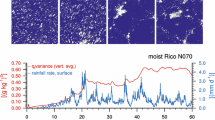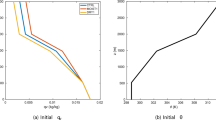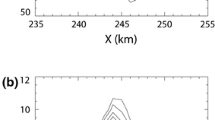Abstract
For numerical weather prediction models and models resolving deep convection, shallow convective ascents are subgrid processes that are not parameterized by classical local turbulent schemes. The mass flux formulation of convective mixing is now largely accepted as an efficient approach for parameterizing the contribution of larger plumes in convective dry and cloudy boundary layers. We propose a new formulation of the EDMF scheme (for Eddy Diffusivity\Mass Flux) based on a single updraft that improves the representation of dry thermals and shallow convective clouds and conserves a correct representation of stratocumulus in mesoscale models. The definition of entrainment and detrainment in the dry part of the updraft is original, and is specified as proportional to the ratio of buoyancy to vertical velocity. In the cloudy part of the updraft, the classical buoyancy sorting approach is chosen. The main closure of the scheme is based on the mass flux near the surface, which is proportional to the sub-cloud layer convective velocity scale w *. The link with the prognostic grid-scale cloud content and cloud cover and the projection on the non- conservative variables is processed by the cloud scheme. The validation of this new formulation using large-eddy simulations focused on showing the robustness of the scheme to represent three different boundary layer regimes. For dry convective cases, this parameterization enables a correct representation of the countergradient zone where the mass flux part represents the top entrainment (IHOP case). It can also handle the diurnal cycle of boundary-layer cumulus clouds (EUROCS\ARM) and conserve a realistic evolution of stratocumulus (EUROCS\FIRE).
Similar content being viewed by others
References
Arakawa A (2004) The cumulus parameterization problem: past present and future. J Clim 17: 2493–2525
Arakawa A, Schubert WH (1974) Interaction of a cumulus cloud ensemble with the large-scale environment, Part 1. J Atmos Sci 31: 674–700
Bechtold P, Cuijpers JWM (1995) Cloud perturbations of temperature and humidity: a LES study. Boundary-Layer Meteorol 76: 377–386
Bechtold P, Bazile E, Guichard F, Mascart P, Richard E (2001) A mass-flux convection scheme for regional and global models. Q J Roy Meteorol Soc 127: 869–886
Berg LK, Stull RB (2002) Accuracy of point and line measures of boundary layer cloud amount. J Appl Meteorol 41: 640–650
Betts AK (1973) Nonprecipitatting cumulus convection and its parameterization. Q J Roy Meteorol Soc 99: 178–196
Bougeault P, Lacarrère P (1989) Parameterization of orography-induced turbulence in a mesobeta-scale model. Mon Weather Rev 117: 1872–1890
Brown A, Cederwall RT, Chlond A, Duynkerke PG, Golaz JC, Khairoutdinov M, Lewellen D, Lock AP, Macvean MK, Moeng CH, Neggers RAJ, Siebesma P, Stevens B (2002) Large-eddy simulation of the diurnal cycle of shallow cumulus convection over land. Q J Roy Meteorol Soc 128: 1075–1093
Browning KA (1993) The GEWEX Cloud System Study (GCSS). Bull Am Meteorol Soc 74: 387–399
Buckingham E (1914) On physically similar systems: illustrations of the use of dimensional equations. Phys Rev IV: 345–376
Cheinet S (2003) A multiple mass-flux parameterization for the surface-generated convection, Part 1: dry plumes. J Atmos Sci 60: 2313–2327
Clarke RH, Dyer AJ, Reid DG, Troup AJ (1971) The Wangara experiment: boundarylayer data. Division Meteorological Physics Paper No. 19: CSIRO, Australia
Couvreux F, Guichard F, Redelsperger JL, Kiemle C, Masson V, Lafore JP, Flamant C (2005) Water–vapour variablility within a convective boundary-layer assessed by large-eddy simulations and IHOP2002 observations. Q J Roy Meteorol Soc 131: 2665–2693
Cuijpers JWM, Holtslag AM (1998) Impact of skewness and nonlocal effects on scalar and buoyancy fluxes in convective boundary layers. J Atmos Sci 55: 151–162
Cuxart J, Bougeault P, Redelsperger JL (2000) A turbulence scheme allowing for mesoscale and large-eddy simulations. Q J Roy Meteorol Soc 126: 1–30
De Roode SR, Duynkerke PG, Siebesma P (2000) Analogies between mass-flux and Reynolds-averaged equations. J Atmos Sci 57: 1585–1598
De Rooy WC, Siebesma P (2008) A simple parameterization for detrainment in shallow cumulus. Mon Weather Rev 136: 560–576
Deardorff JW (1966) The counter-gradient heat flux in the lower atmosphere and in the laboratory. J Atmos Sci 23: 503–506
Deardorff JW (1980a) Cloud top entrainment instability. J Atmos Sci 37: 131–147
Deardorff JW (1980b) Stratocumulus-capped mixed layers derived from a three-dimensionnal model. Boundary-Layer Meteorol 18: 495–527
Duynkerke PG, Hignett P (1995) Simulation of diurnal variation in a stratocumulus-capped marine boundary layer during FIRE. Mon Weather Rev 52: 2763–2777
Duynkerke PG, Zhang H, Jonker PJ (1995) Microphysical and turbulent structure of nocturnal stratocumulus as observed during astex. J Atmos Sci 52: 2763–2777
Duynkerke PG, De Roode SR, Van Zanten MC, Calvo J, Cuxart J, Cheinet S, Chlond A, Grenier H, Jonker PJ, Kohler M, Lenderink G, Lewellen D, Lappen CL, Lock AP, Moeng CH, Muller F, Olmeda D, Piriou JM, Sanchez E, Sednev I (2004) Observations and numerical simulations of the diurnal cycle of the EUROCS stratocumulus case. Q J Roy Meteorol Soc 130: 3269–3296
Grant ALM (2001) Cloud-base fluxes in the cumulus-capped boundary layer. Q J Roy Meteorol Soc 127: 407–421
Gregory D, Kershaw R, Inness PM (1997) Parametrization of momentum transport by convection. II: tests in single-column and general circulation models. Q J Roy Meteorol Soc 123: 1153–1183
Hignett P (1991) Observations of the diurnal variation in the cloud-capped marine boundary layer. J Atmos Sci 45: 1474–1482
Holland JZ, Rasmusson EM (1973) Measurement of atmospheric mass, energy and Momentum budgets over a 500-kilometer square of tropical ocean. Mon Weather Rev 101: 44–55
Holtslag AAM, Moeng CH (1991) Eddy diffusivity and countergradient transport in the convective atmospheric boundary layer. J Atmos Sci 48: 1690–1698
Hourdin F, Couvreux F, Menut L (2002) Parameterization of the dry convective boundary layer based on a mass flux representation of thermals. J Atmos Sci 59: 1105–1122
Kain JS, Fritsch JM (1990) A one-dimensionnal entraining/detraining plume model and its application in convective parameterization. J Atmos Sci 47: 2784–2802
Lafore JP, Stein J, Asencio N, Bougeault P, Ducrocq V, Duron J, Fisher C, Hereil P, Mascart P, Masson V, Pinty JP, Redelsperger JL, Richard E, Arellano JV (1998) The meso-NH atmospheric simulation system, Part I: adiabatic formulation and control simulations. Ann Geophys 16: 90–109
Lappen CL, Randall DA (2001) Toward a unified parameterization of the boundary layer and moist convection, Part 2: lateral mass exchanges and subplume-scale fluxes. J Atmos Sci 58: 2037–2051
Lenderink G, Siebesma P, Cheinet S, Irons S, Jones CG, Marquet P, Muller F, Olmeda D, Calvo J, Sanchez E, Soares PMM (2004) The diurnal cycle of shallow cumulus clouds over land: a single column model intercomparaison study. Q J Roy Meteorol Soc 130: 3339–3364
Lewellen D, Lewellen W (1998) Large-eddy boundary layer entrainment. J Atmos Sci 55: 2645–2665
Lewellen D, Lewellen W (2002) Entrainment and decoupling relations for cloudy boundary layers. J Atmos Sci 59: 2966–2987
Lilly DK (1968) Models of cloud-topped mixed layers under a strong inversion. Q J Roy Meteorol Soc 94: 292–309
Neggers RAJ, Siebesma P, Jonker HJJ (2002) A multiparcel model for shallow cumulus convection. J Atmos Sci 59: 1655–1668
Neggers RAJ, Siebesma AP, Lenderink G, Holtslag AM (2004) An evaluation of mass flux closures for diurnal cycles of shallow cumulus. Mon Weather Rev 132: 2525–2538
Nicholls S (1984) The dynamics of stratocumulus: aircraft observations and comparisons with a mixed layer model. Q J Roy Meteorol Soc 110: 783–820
Ooyama K (1971) A theory on parameterization of cumulus convection. J Meteorol Soc Jpn 49: 744–756
Randall DA (1980) Conditionnal instability of the first kind upside-down. J Atmos Sci 37: 125–130
Rio C, Hourdin F (2008) A thermal plume model for the convective boundary layer. J Atmos Sci 65: 407–425
Schumann U (1987) The countergradient heat flux in stratified turbulent flows. Nucl Eng Des 100: 255–262
Siebesma P (1998) Shallow cumulus convection. In: Plate EJ et al (eds) Buoyant convection in geophysical flows. Kluwer, Amsterdam, pp 441–486
Siebesma P, Cuijpers JWM (1995) Evaluation of parametric assumptions for shallow cumulus convection. J Atmos Sci 53: 650–666
Siebesma P, Holtslag AM (1996) Model impacts of entrainment and detrainment rates in shallow cumulus convection. J Atmos Sci 53: 2354–2364
Siebesma P, Teixeira J (2000) An advection-diffusion scheme for the convective boundary layer, description and 1D results. In: Proceedings of 14th symposium on boundary layers and turbulence, Aspen, USA, pp 133–136
Siebesma P, Bretherton CS, Brown A, Chlond A, Cuxart J, Duynkerke PG, Jiang H, Khairoutdinov M, Lewellen D, Moeng CH, Sanchez E, Stevens B, Stevens DE (2003) A large eddy simulation intercomparison study of shallow cumulus convection. J Atmos Sci 60: 1201–1219
Siebesma P, Soares PMM, Teixeira J (2007) A combined eddy-diffusivity mass-flux approach for the convective boundary layer. J Atmos Sci 64: 1230–1248
Simpson J, Wiggert V (1969) Models of precipitating cumulus towers. Mon Weather Rev 97: 471–489
Soares PMM, Miranda PMA, Siebesma AP, Teixeira J (2004) An eddy-diffusivity/mass-flux parameterization for dry and shallow cumulus convection. Q J Roy Meteorol Soc 130: 3055–3079
Stull RB (1988) An introduction to boundary layer meteorology. Kluwer, Dordrecht, p 666
Sullivan PP, Moeng CH, Stevens B, Lenschow DH, Mayor SD (1998) Structure of the entrainment zone capping the convective. J Atmos Sci 55: 3042–3064
Taylor GR, Baker MB (1991) Entrainment and detrainment in cumulus clouds. J Atmos Sci 48: 112–121
Teixeira J, Stevens B, Bretherton CS, Cederwall R, Doyle JD, Golaz JC, Holtslag AMM, Klein SA, Lundquist JK, Randall DA, Siebesma AP, Soares PMM (2008) Parameterization of the atmospheric boundary layer: a view from just above the inversion. Bull Am Meteorol Soc 89: 453–458
Tiedtke M (1989) A comprehensive mass-flux scheme for cumulus parameterization in large-scale models. Mon Weather Rev 177: 1779–1800
Tomas S, Masson V (2006) A parametrization of third order moments for dry convective boundary layer. Boundary-Layer Meteorol 120: 437–454
Troen IB, Mahrt L (1986) A simple model of the atmospheric boundary layer: sensitivity to surface evaporation. Boundary-Layer Meteorol 37: 129–148
Wang S, Stevens B (2000) Top-hat representation of turbulence statistics in cloud-topped boundary layers: a large eddy simulation study. J Atmos Sci 57: 423–441
Weckwerth TM, Parsons DB, Koch SE, Moore JA, Lemone MA, Demoz BR, Flamant C, Geerts B, Wang J, Feltz W (2004) An overview of the international H2O project (IHOP_2002) and some preliminary highlights. Bull Am Meteorol Soc 85: 253–277
Wood R, Bretherton CS, Hartmann DL (2002) Diurnal cycle of liquid water path over the subtropical and tropical oceans. Geophys Res Lett 29: 7.1–7.4
Yanai M, Esbensen S, Chu J (1973) Determination of bulk properties of tropical cloud clusters from large-scale heat and moisture budgets. J Atmos Sci 30: 611–627
Young GS (1988) Turbulence structure of the convective boundary layer, Part II: Phoenix 78 Aircraft observations of thermals and their environment. J Atmos Sci 45: 727–735
Zhao M, Austin PH (2003) Episodic mixing and buoyancy-sorting representations of shallow convection: a diagnostic study. J Atmos Sci 60: 892–912
Author information
Authors and Affiliations
Corresponding author
Rights and permissions
About this article
Cite this article
Pergaud, J., Masson, V., Malardel, S. et al. A Parameterization of Dry Thermals and Shallow Cumuli for Mesoscale Numerical Weather Prediction. Boundary-Layer Meteorol 132, 83–106 (2009). https://doi.org/10.1007/s10546-009-9388-0
Received:
Accepted:
Published:
Issue Date:
DOI: https://doi.org/10.1007/s10546-009-9388-0




